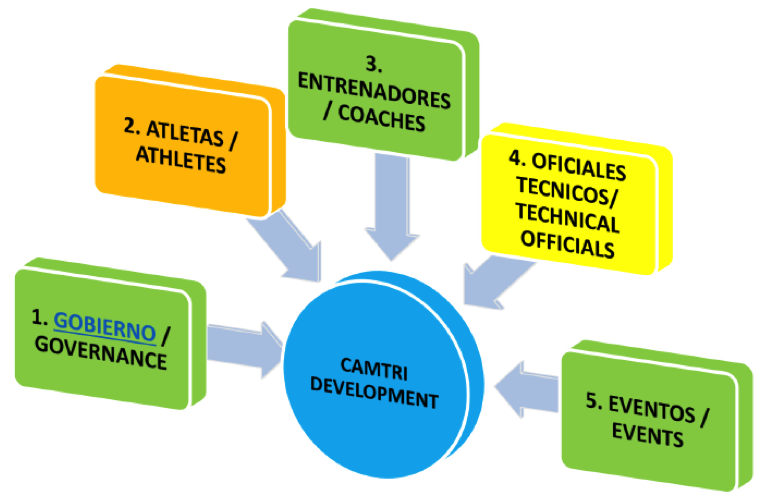A.T. Development Pillars
Updated: 04 Apr, 2024 10:41 pmIn CAMTRI we have defined 5 pillars with the aim of boosting development in the region. Each one has its own strategy and indicators that will allow us to measure the level of progress for the next years.
The main objectives of each pillar are summarized below:

1. GOVERNMENT:
• Promote an active participation in the development of the region through CAMTRI´s National Federations professionalization.
• Increase the number of countries affiliated to the ITU.
2. ATHLETES:
• Increase the number of American countries in the Olympic Games and Youth Olympic Games. Raise the number of countries with development programs for youth, U23 and elite athletes.
• Escalate the participation of youth, U23 and elite athletes in international competitions inside and outside the American continent.
• Increase the number of licenses in lower categories and promote gender equity among all of them.
• Improve the position in the international ranking of CAMTRI athletes.
3. COACHES:
• Augment the number of qualified coaches at all levels.
• Increase the number of training courses and training programs certified by the ITU.
• Promote gender equity within National Federations of trainers attending the courses and members of national teams.
4. OFFICIALS:
• Enlarge the number of qualified officers at all levels.
• Increase the number of courses and training programs for ITU-certified officers.
• Promote gender equity within the National Federations of those who attend the courses and CAMTRI competitions.
5. COMPETITIONS:
• Increase the number and quality of competitions and variety among the entire continent.
• Augment the number of participants, especially the youngest ones in order to have a larger base of athletes in the future.
• Multiply and maintain the number of international venues for several years. Increase the number of WC and WTS among the continent.
_______________________________________________________________________________________________________________________________________
(Spanish)
En la CAMTRI hemos definido 5 pilares con el objetivo de impulsar el desarrollo en la región. Cada uno cuenta con su propia estrategia e indicadores que nos permitirán medir el nivel de avance para los próximos años.
Los objetivos principales de cada pilar se resumen a continuación
1. GOBIERNO:
• Promover la participación activa en el desarrollo de la región del total de países CAMTRI.
• Profesionalizar los equipos de trabajo de las Federaciones Nacionales con el personal profesional contratado.
• Incrementar el número de países afiliados a la ITU.
2. ATLETAS:
• Incrementar el número de países de América en Juegos Olímpicos y Juegos Olímpicos de la Juventud.
• Aumentar el número de países con programas de desarrollo de atletas juveniles y de atletas sub23 y élite.
• Elevar la participación de los atletas juveniles, sub23 y élite en las competiciones internacionales dentro y fuera del continente americano.
• Incrementar el número de licencias en categorías inferiores y promover la equidad de género en todas las categorías.
• Mejorar la posición en el ranking internacional de los atletas CAMTRI.
3. ENTRENADORES:
• Aumentar el número de entrenadores titulados en todos los niveles.
• Incrementar el número de cursos y programas de formación de entrenadores certificados por la ITU.
• Promover la equidad de género en las Federaciones Nacionales en la asistencia a los cursos y en las convocatorias de los equipos nacionales.
4. OFICIALES:
• Incrementar el número de oficiales titulados en todos los niveles.
• Aumentar el número de cursos y programas de formación de oficiales certificados por la ITU.
• Promover la equidad de género en las Federaciones Nacionales en la asistencia a los cursos y en las convocatorias de las competiciones CAMTRI.
5. COMPETICIONES:
• Incrementar el número de competiciones de calidad y variedad en todos los países de América.
• Elevar el número de participantes, en especial de los más jóvenes para tener una gran base de atletas a futuro.
• Aumentar el número de sedes de competiciones internacionales y conservar esas sedes de manera estable durante varios años.
• Incrementar el número de sede de WC y WTS en América.
